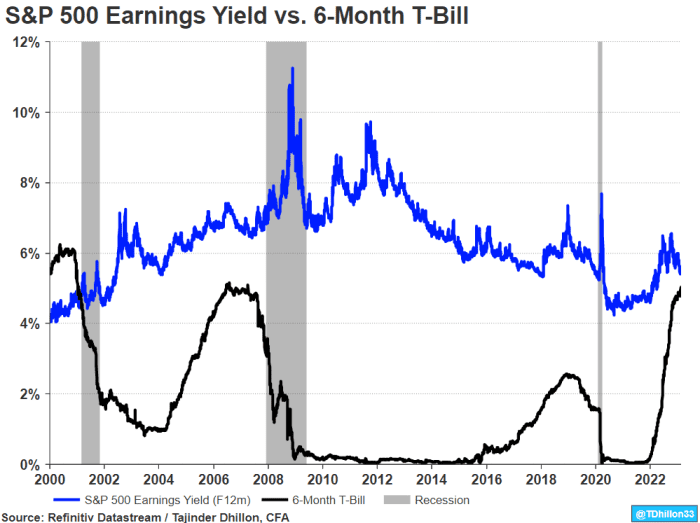#Market Snapshot: Stocks are tumbling. Why ‘cash’ yielding more than it has since 2007 could be king.

Table of Contents
“Market Snapshot: Stocks are tumbling. Why ‘cash’ yielding more than it has since 2007 could be king.”
Cash is king!?
When a $6 plastic crown can fetch almost $600,000 at auction, it’s safe to say the value has been inflated.
The harder question for investors nearly a year into the Federal Reserve’s inflation fight is whether buying the dip in stocks is wise, or earning a cool 5% yield on safe-haven Treasury bills, a cash equivalent, makes more sense.
Specifically, the earnings yield of the companies in the S&P 500 index
SPX,
converged in the past week with the 6-month Treasury
TMUBMUSD06M,
rate, with both meeting around 5%, for the first time in about 20 years (see chart).

U.S. stock market earnings yield and 6-month Treasury rate converge in early 2023 around 5%
Refinitiv
The earnings yield looks at the past 12 months of earnings, divided by share price. It also is a gauge of which assets are overpriced or underpriced.
“I think what you make of it is bonds are back,” said Kathy Jones, chief fixed-income strategist at Schwab Center for Financial Research, noting the two yields used to track more closely for many years in the 1980s and 1990s. “It’s probably new for a lot of investment managers and individual investors.”
Schwab’s house view on equities has been cautious for awhile, including that higher-growth stocks could be vulnerable to further pullbacks as the Fed continues to tightening financial conditions.
Jones said the chance to earn 5% with bonds looks “very attractive, and probably allows an investor to ride out more ups and downs in the equity portion of their portfolio, and not by taking as much risk.”
Fund flows into bonds
Investors appear to be liking today’s higher bond yields, with roughly $17 billion flowing out of U.S. equity funds this year through Feb. 15 and $4.2 billion flowing into Treasury bond funds, the strongest inflows to U.S government debt funds to start a year since 2004, according to BofA Global data.
“Why not take 4.8% or 5% on a yield basis that’s risk-free,” said Stephen Guilfoyle, founder and president of Sarge986, a private family trading operation, and a former NYSE floor trader. “I’m moving some of my cash to 3-month paper and I’m really an equities guy.”
The 3-month Treasury rate
TMUBMUSD03M,
was near 4.9% on Tuesday, while the 2-year Treasury
TMUBMUSD02Y,
was at 4.7%, near its highest since 2007, and the 10-year yield
TMUBMUSD10Y,
was around 4%, according to Dow Jones Market Data.
U.S. stocks were sharply lower Tuesday, a week after the consumer-price index showed inflation might need higher interest rates to recede more quickly. Economists at Goldman Sachs and Bank of America revised their forecasts to include interest rate increases of 25 basis-point hikes in March, May and June, which would bring the Fed’s terminal rate to a 5.25% to 5.5% range.
See: ‘Not a time to buy’: S&P 500 exiting ‘best era’ in decades for earnings growth amid ‘dried up’ liquidity
In January, investors who trade in fed-funds futures market were expecting the Fed to stop raising rates at 5%.
Major equity indexes still were up in 2023, driven by hopes that a deep recession can be avoided and the Fed also might scale back the size of its interest rate hikes.
Josh Duitz, deputy head of global equities at abrdn, said equity prices currently reflect a “Goldilocks scenario” where the Fed tames inflation but the economy experiences a shallow recession.
Read: Will recession slam the stock market? Here are 3 ‘landing’ scenarios as Fed keeps up the inflation fight.
But he also thinks equity “valuations got out of hand” in the past 10 to 15 years of low interest rates, especially for growth stocks. Duitz thinks investors should brace for higher rates for longer. “When the cost of capital is higher, those growth names aren’t as attractive,” he said. “Look at the cash companies are producing and paying out to individual shareholders.”
While off earlier highs in 2023, the S&P 500 was up 4.2% on the year through Tuesday, the Dow Jones Industrial Average
DJIA,
was fractionally higher and the Nasdaq Composite Index
COMP,
advanced 10%, according to FactSet.
Where do markets go from here? Who knows. Not everyone saw the value in the Notorious B.I.G. wearing a cheap crown to a 1997 photoshoot, even through, as Rolling Stone magazine points out, it ended up being “one of the most famous hip-hop portraits ever taken.”
Joseph Adinolfi contributed reporting.
By
Joy Wiltermuth
If you liked the article, do not forget to share it with your friends. Follow us on Google News too, click on the star and choose us from your favorites.
For forums sites go to Forum.BuradaBiliyorum.Com
If you want to read more News articles, you can visit our News category.


![#Sixers reportedly end trade talks for James Harden, want him back for next season [Video]](https://s.yimg.com/ny/api/res/1.2/tRdT0a.Z4t.72YGl1DrFgg--/YXBwaWQ9aGlnaGxhbmRlcjt3PTEyMDA7aD04MDA-/https://media.zenfs.com/en/aol_yahoo_sports_800/40b31111d9186e6d6b331e5ff219e159)

